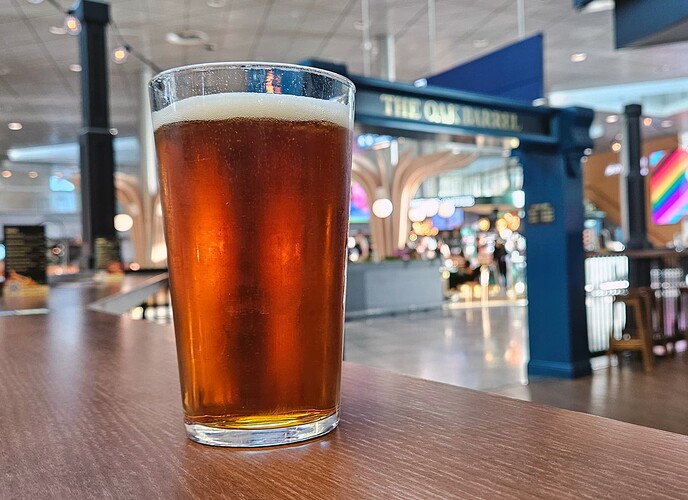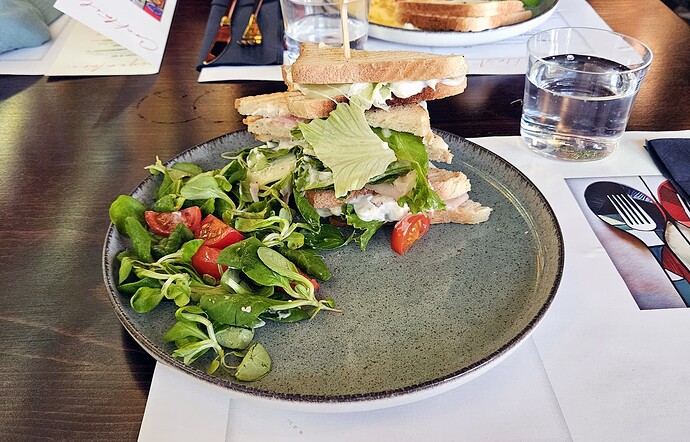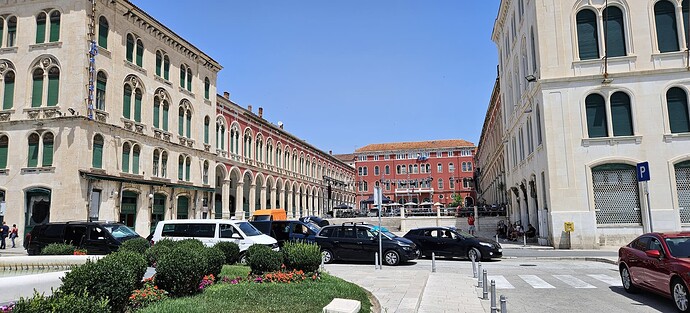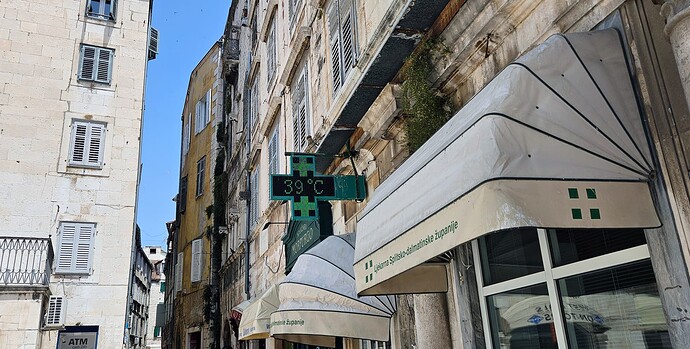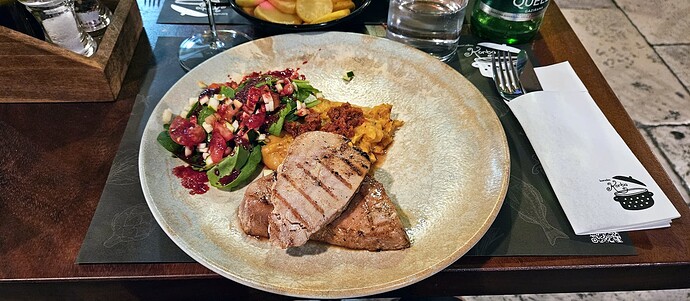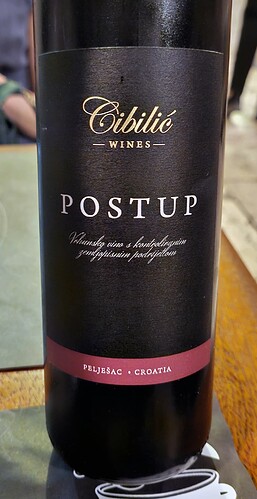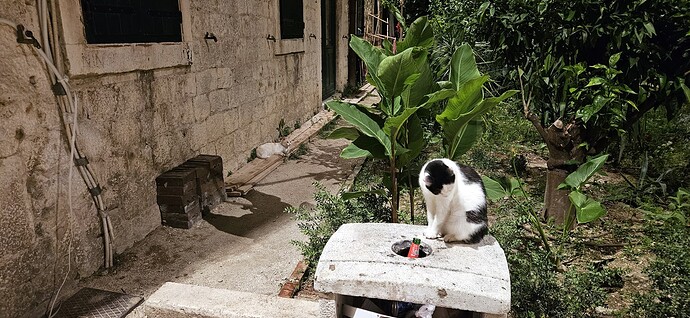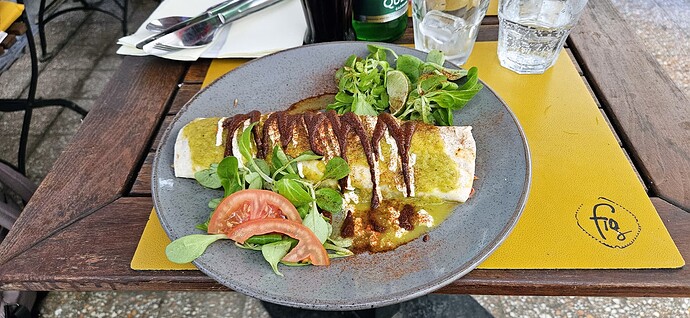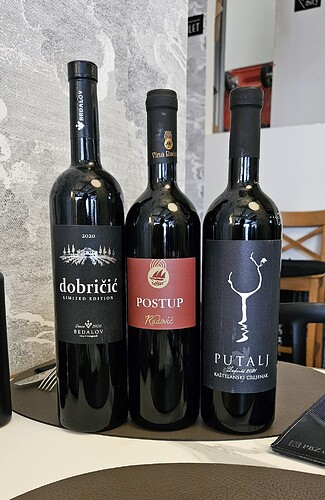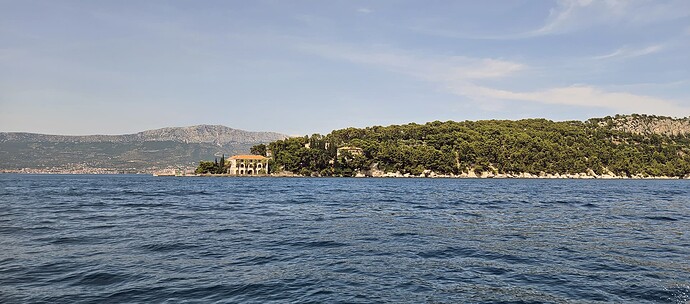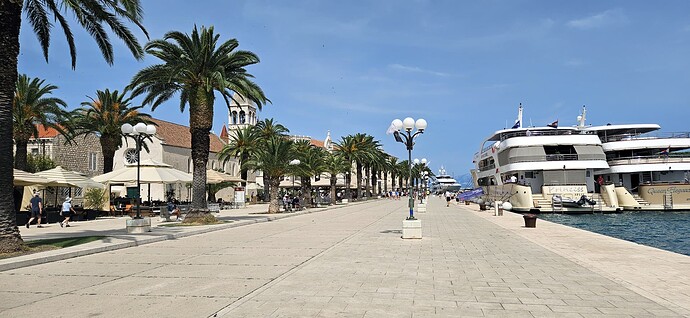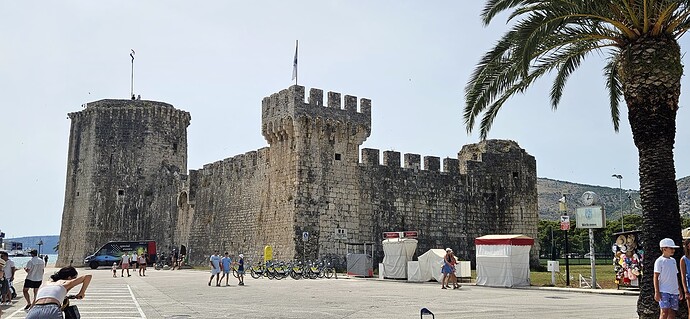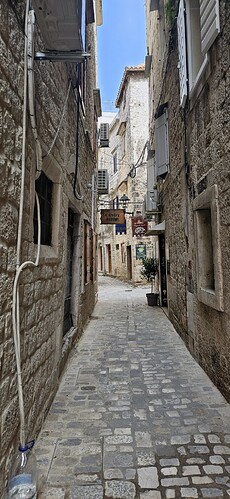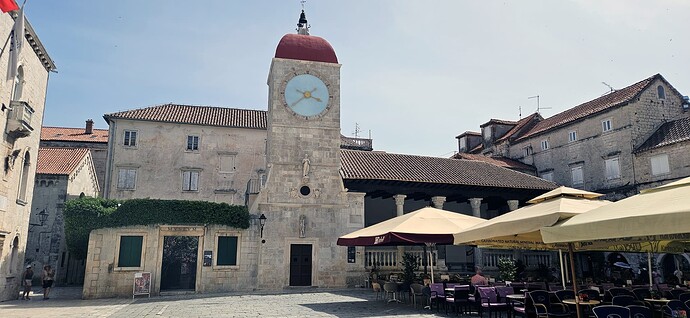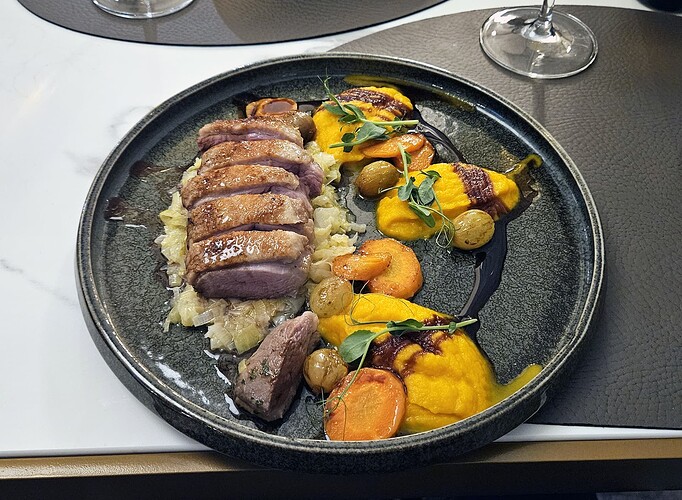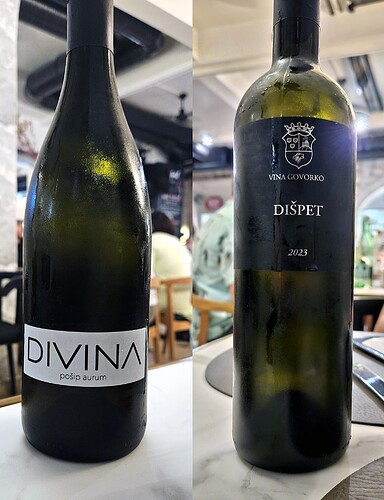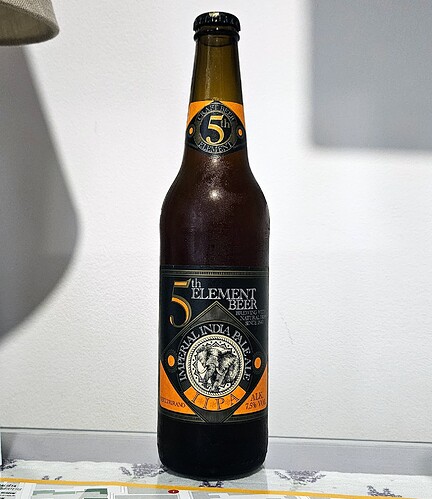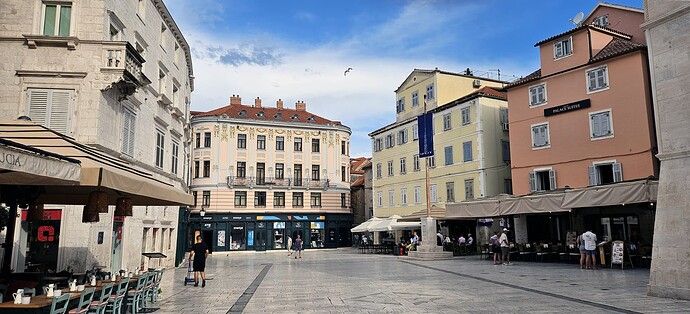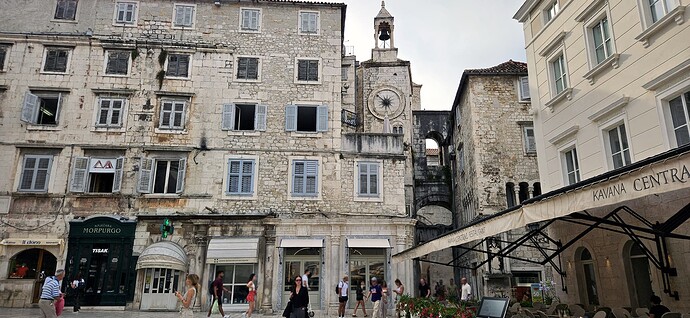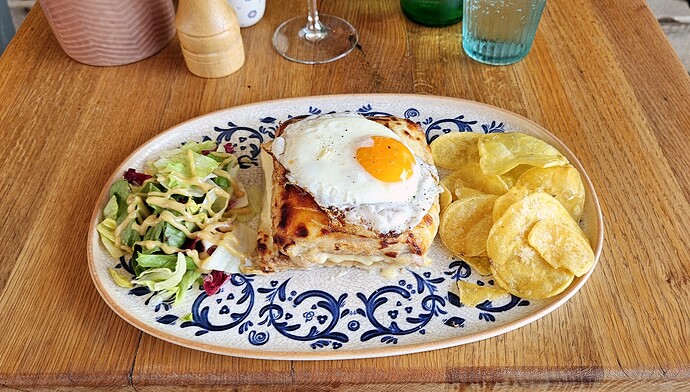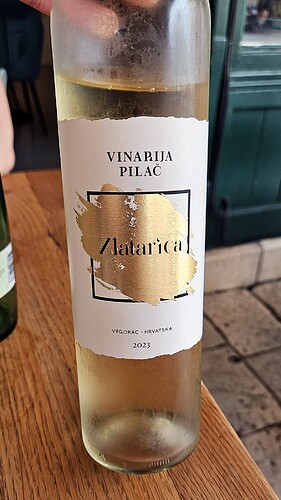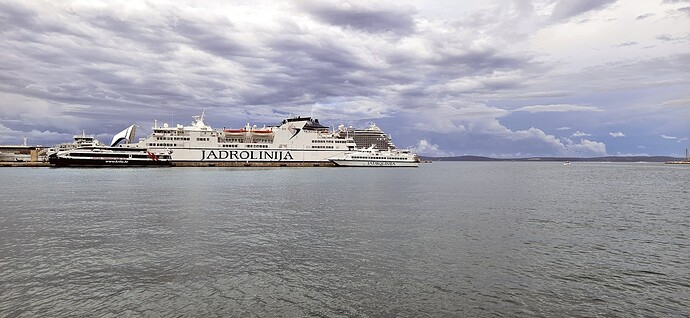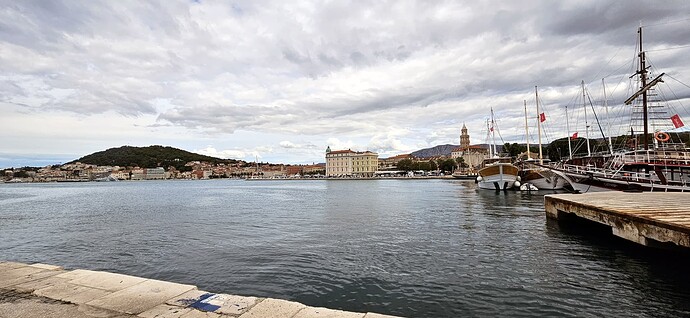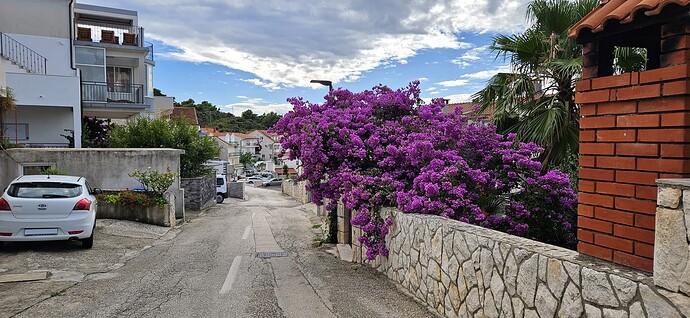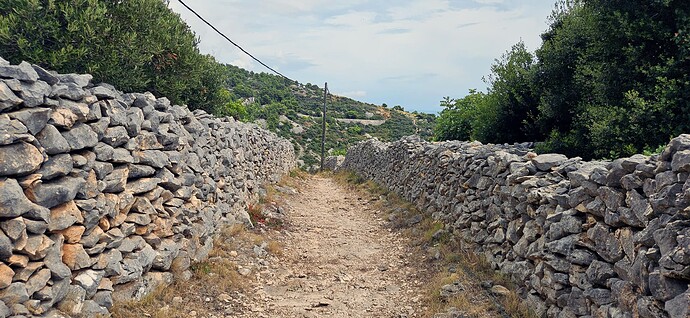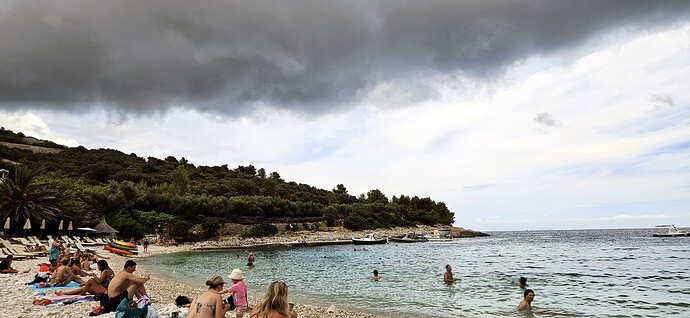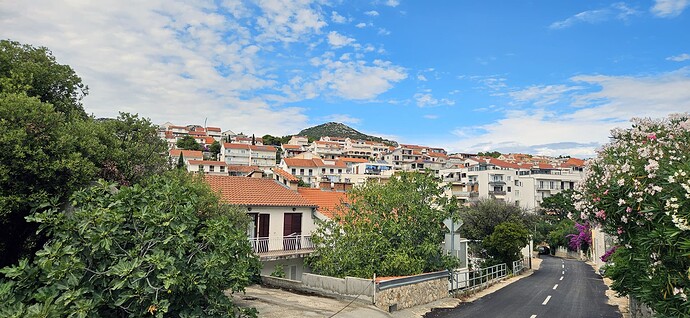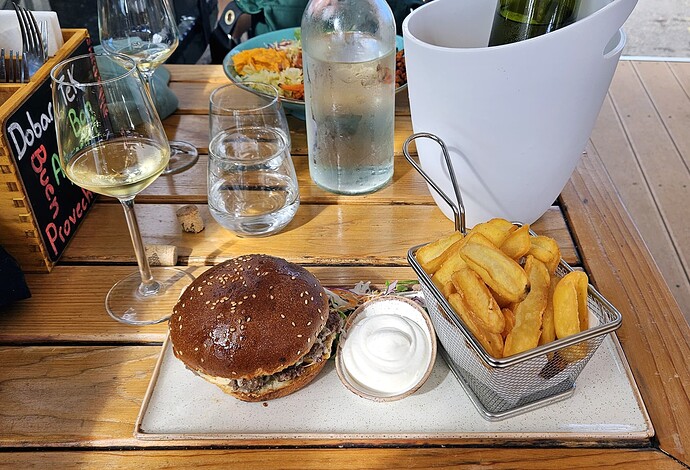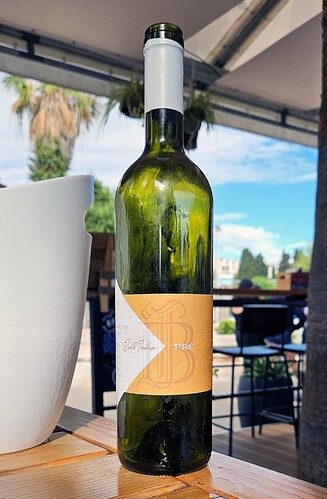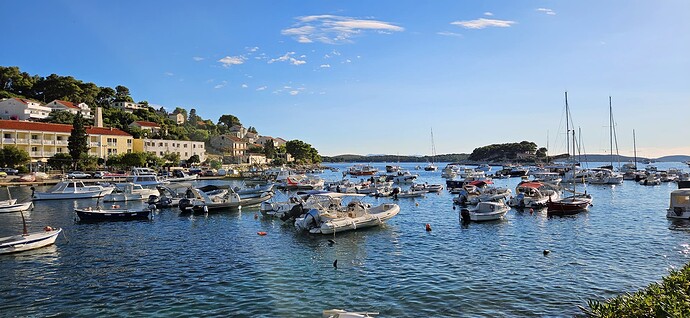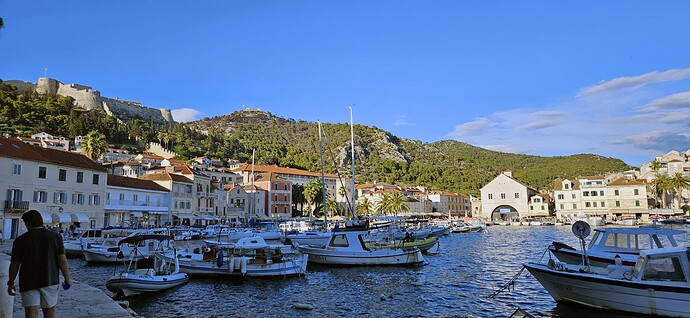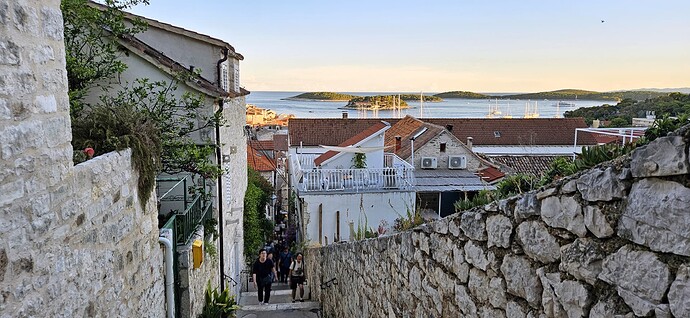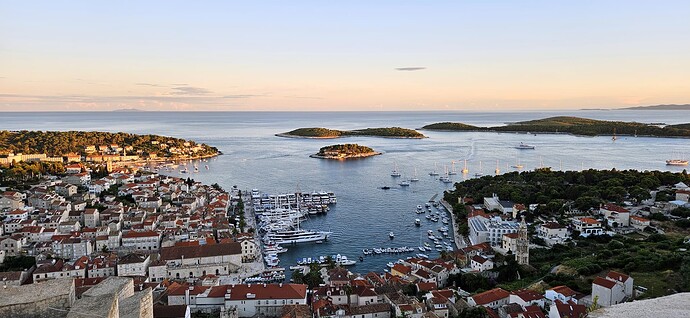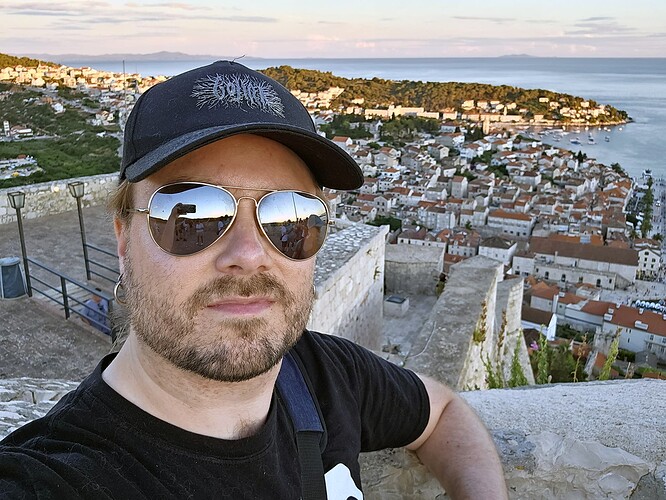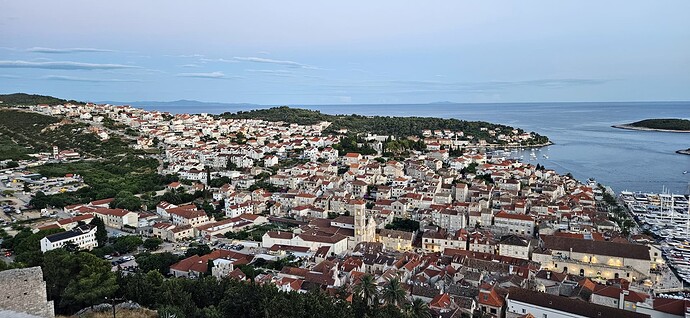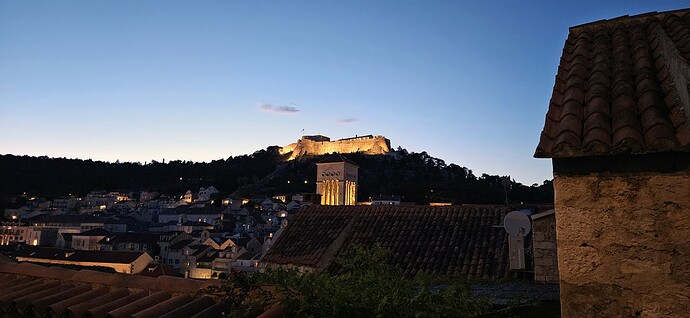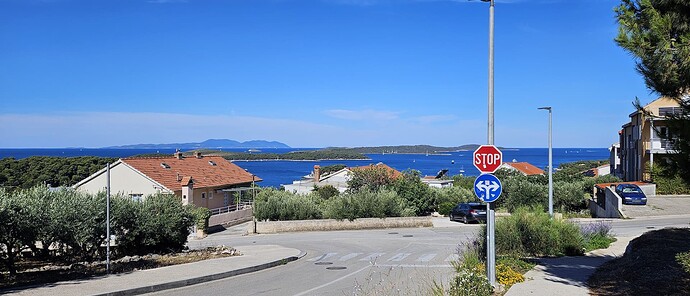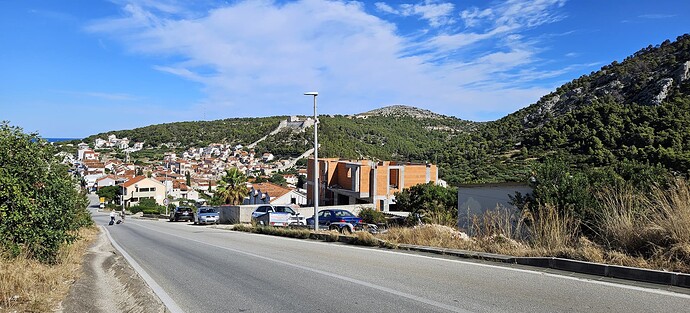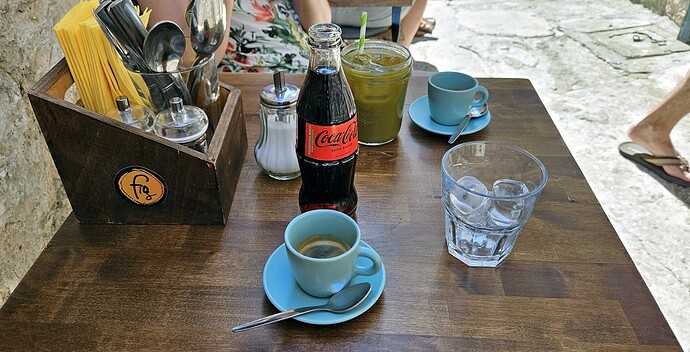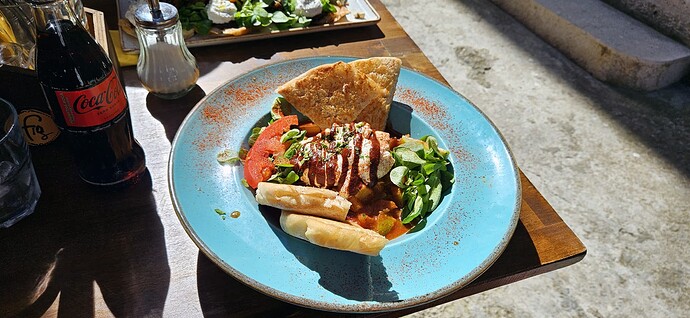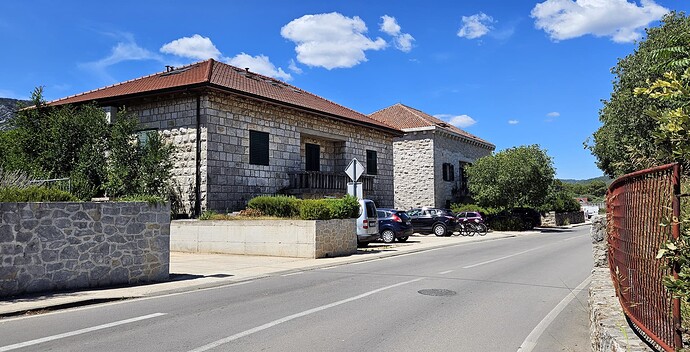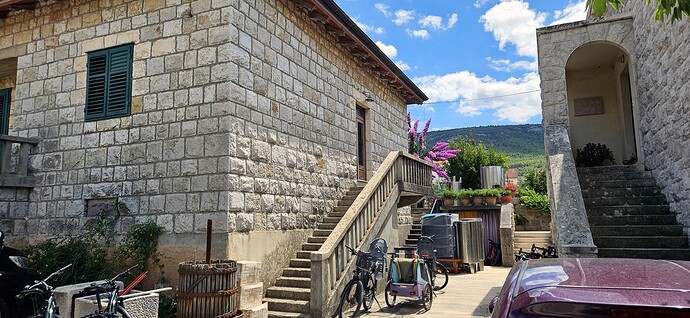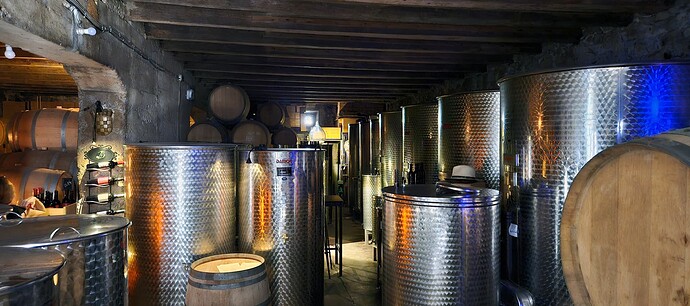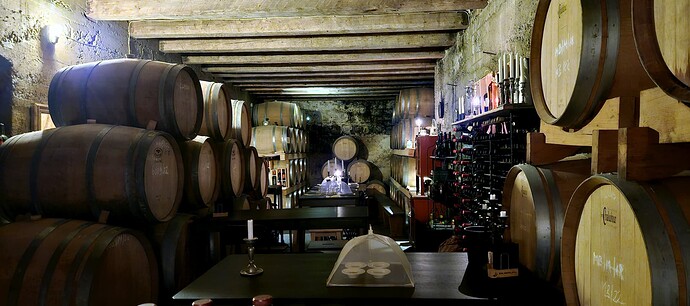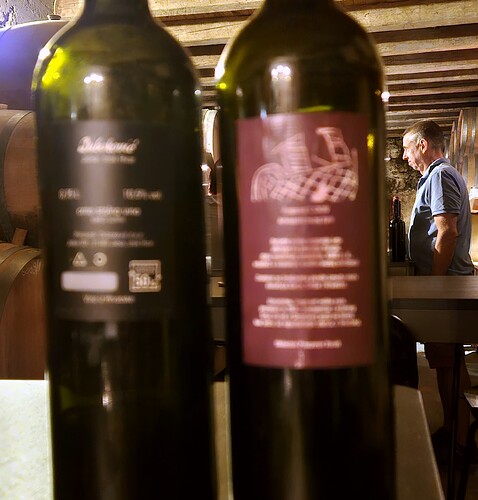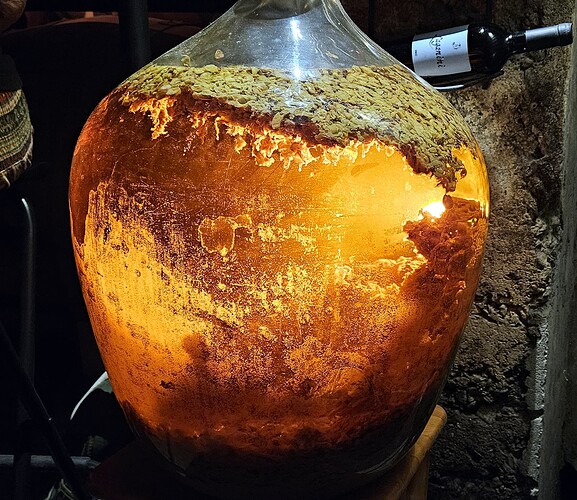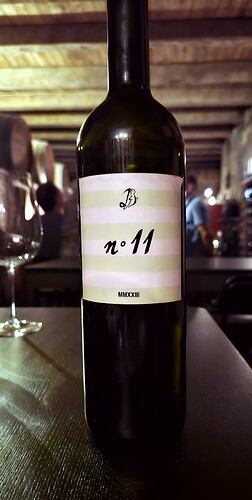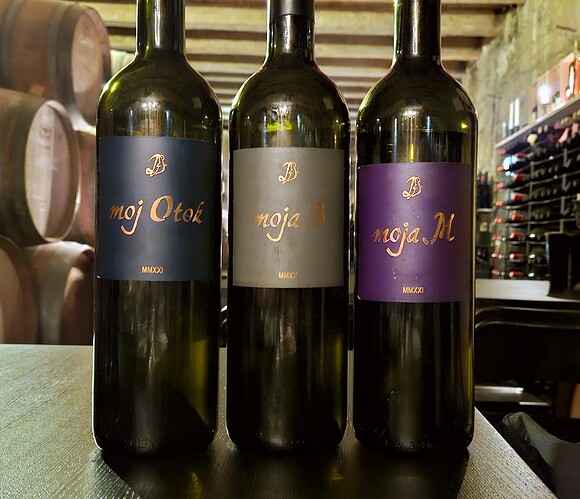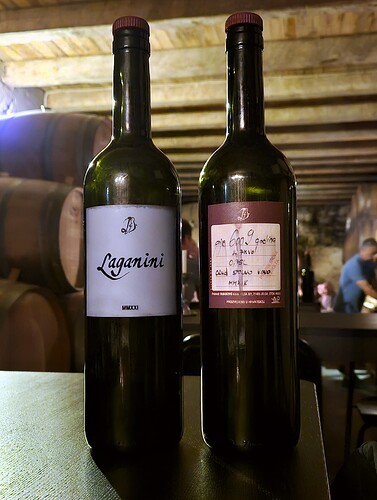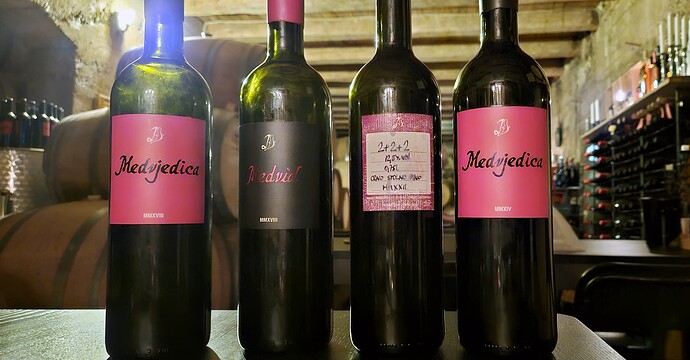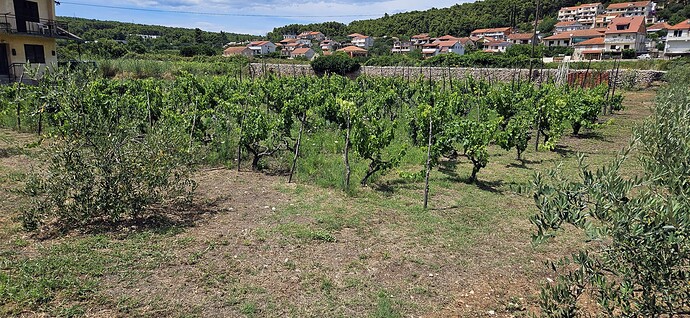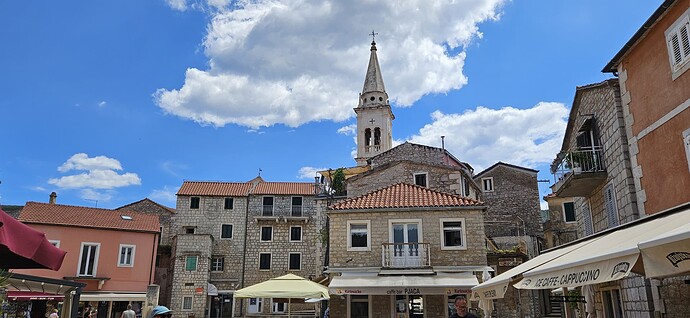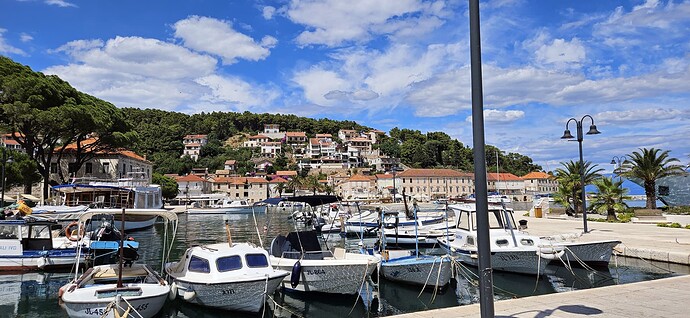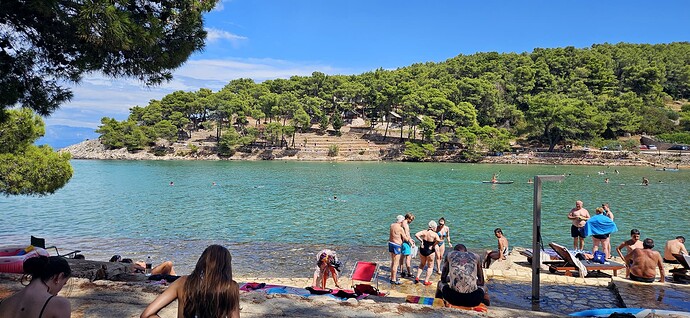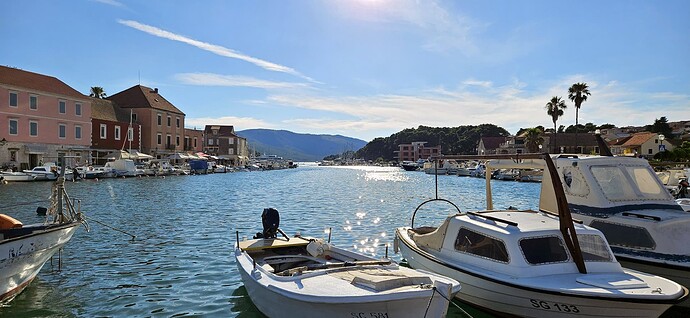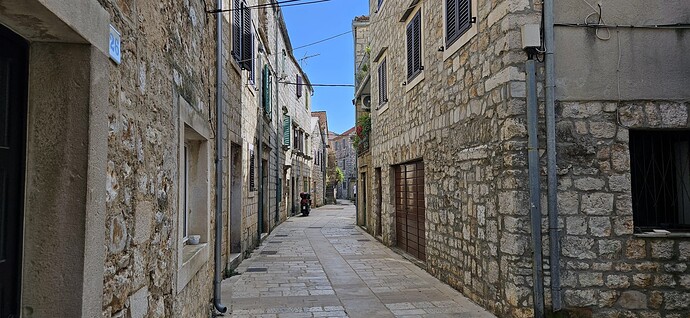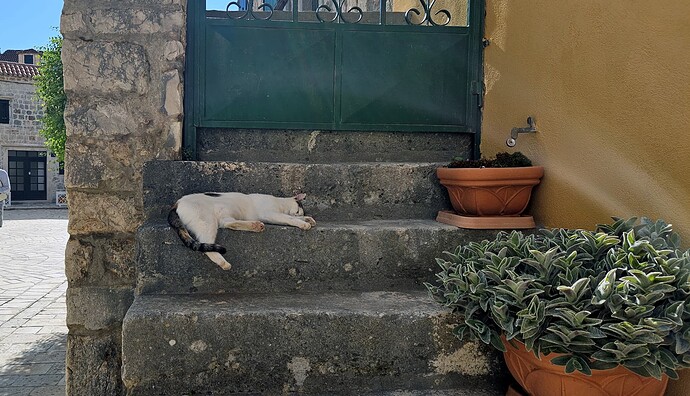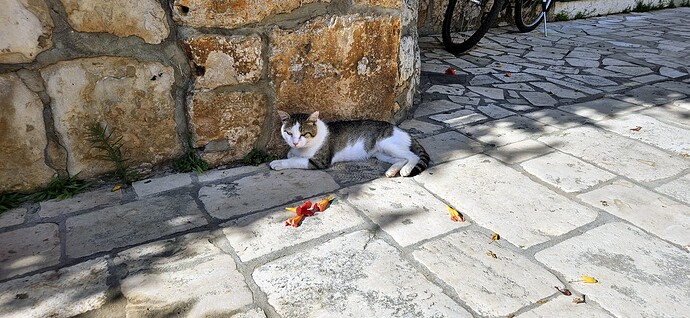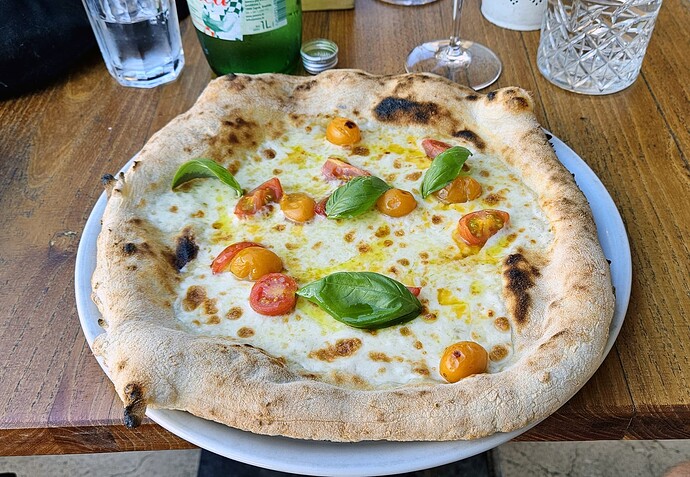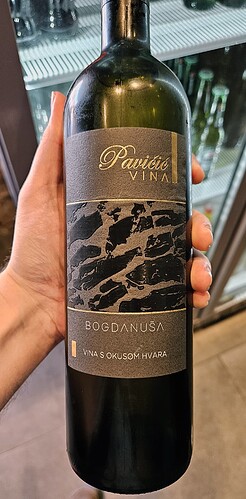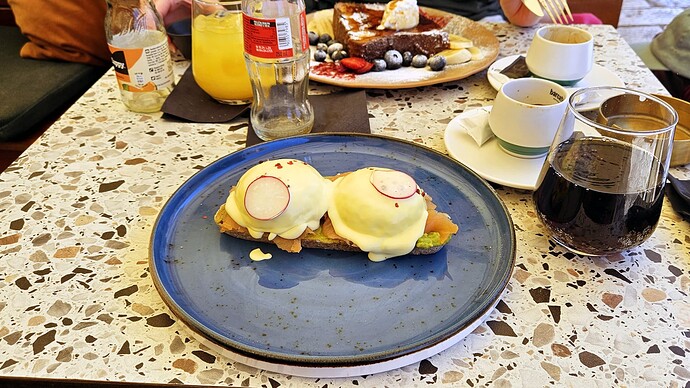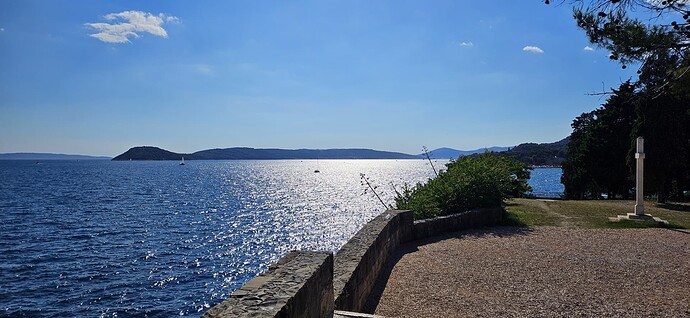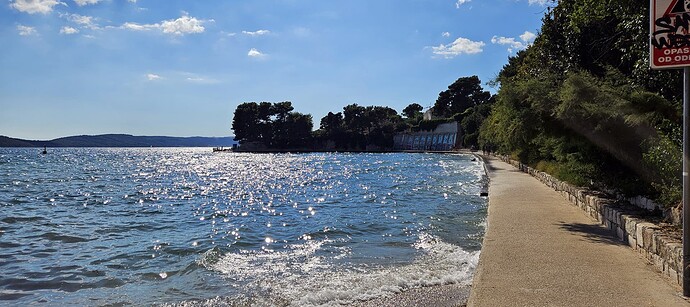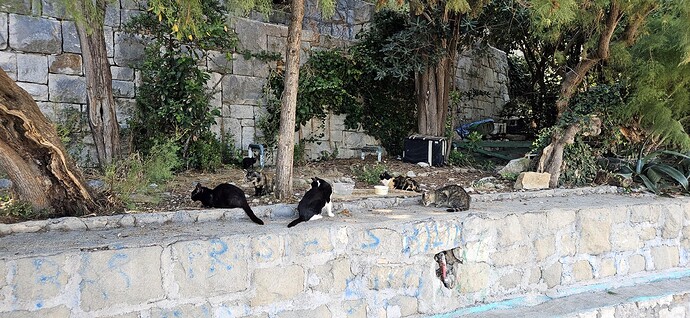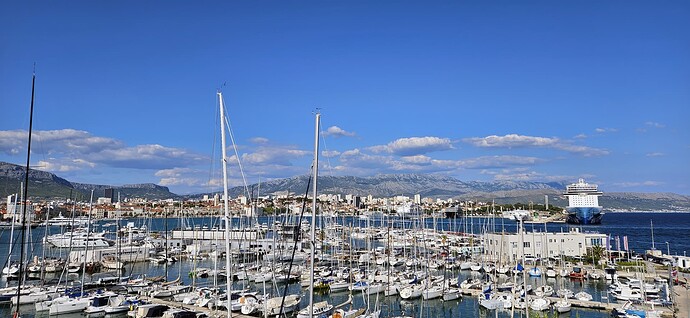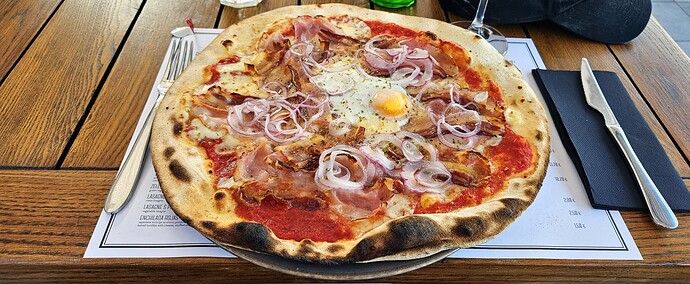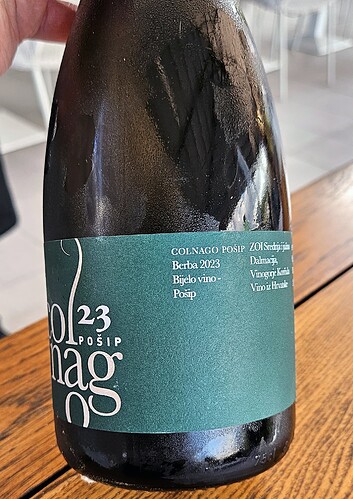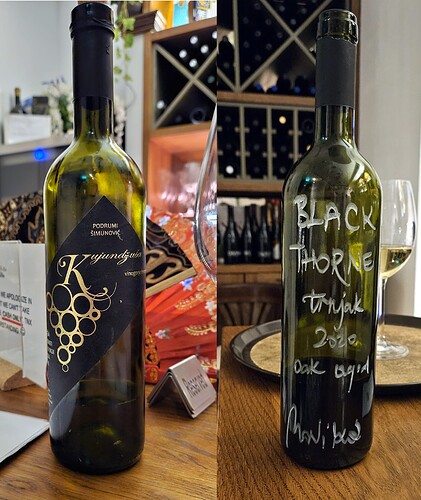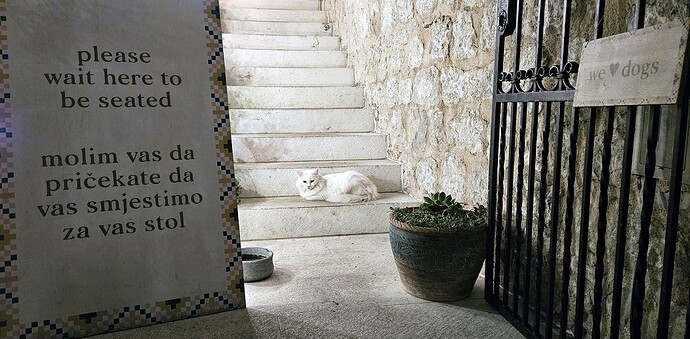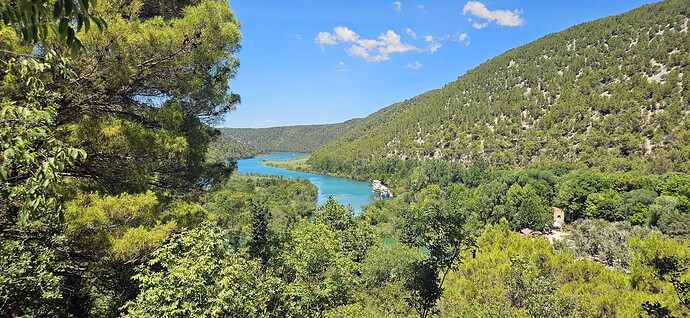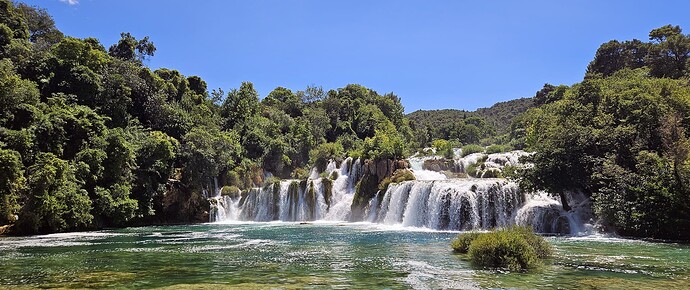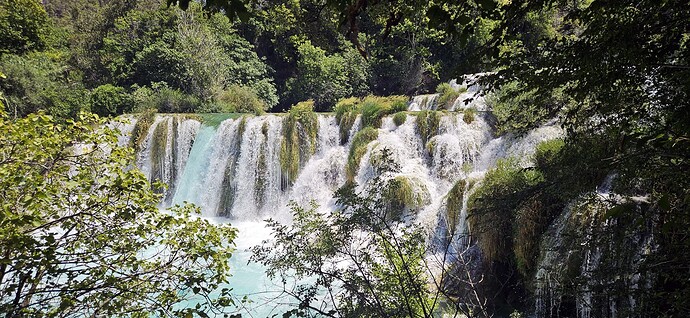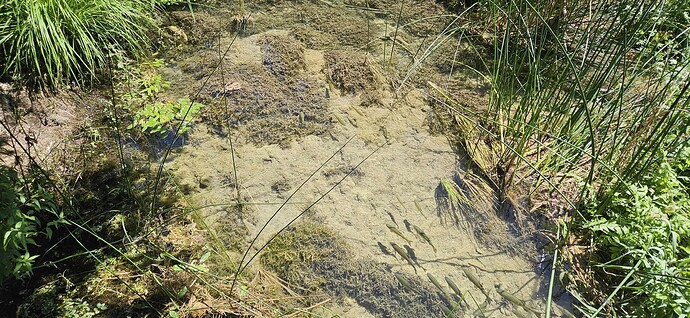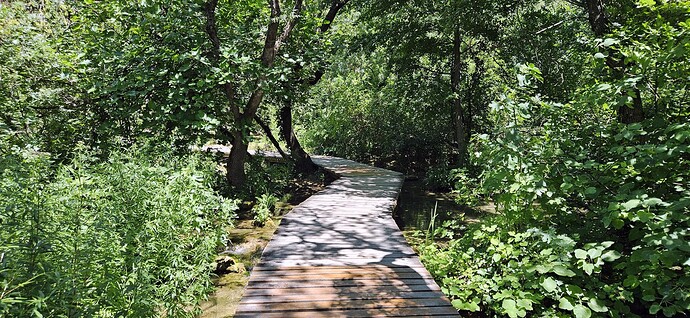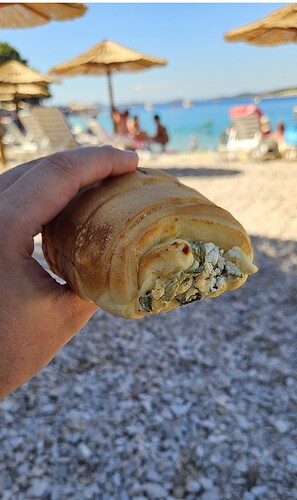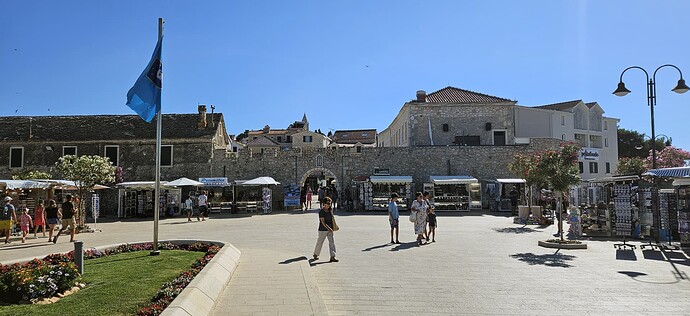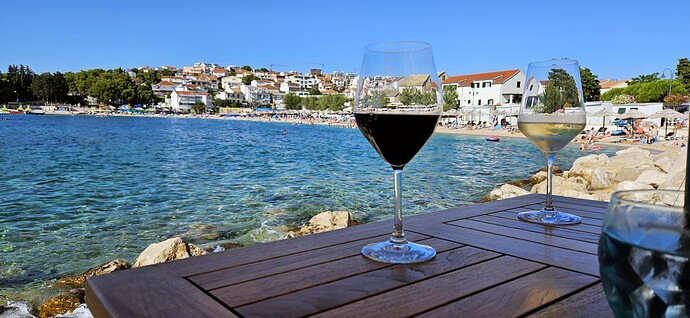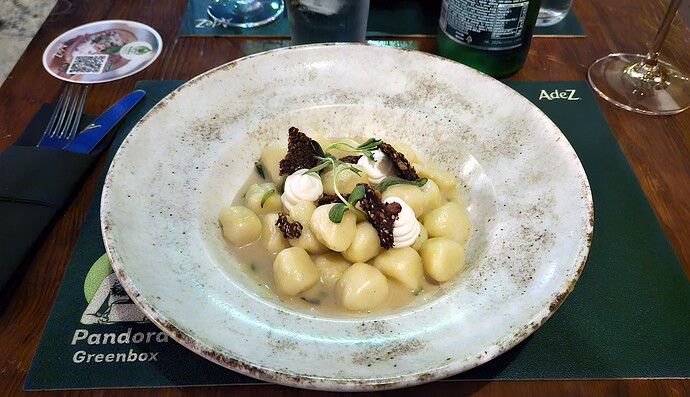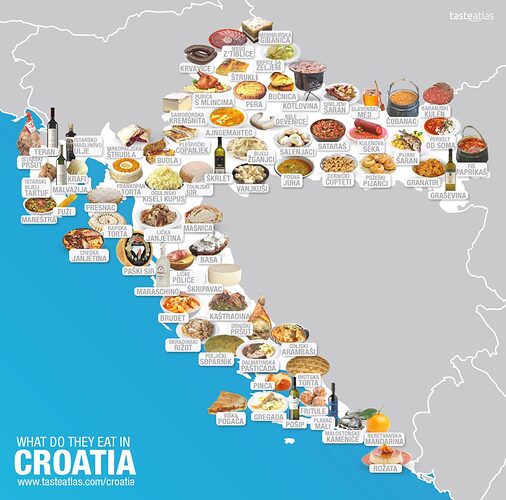Day 4
We had arranged a visit to Duboković for our first whole day at Hvar. However, since the winery is located in Jelsa, a town in a completely different part of the island, getting there took us some planning. There didn’t seem to be any Bolt or Uber cars in Hvar; taxis are forbiddingly expensive there; and renting a car to get to a wine tasting felt somewhat counterproductive. However, it seemed that there was a bus line going from Hvar to Jelsa and back every two hours or so - and the bus stop was almost next to the Duboković winery, so getting there by a bus was a no-brainer!
We departed from our apartment at around 9 am and the bus to Jelsa left at 10:30, so there was going to be more than enough time to get some breakfast!
The views over Vis from the street to our apartment.
The long, steep descent to Hvar.
We went have breakfast at a place quite nearby the bus station. I ordered a coke, an espresso and a spicy shakshuka thing. We got our beverages almost immediately, but apparently we were totally forgotten about after that, because we didn’t get anything for the next 40 minutes or so. After people who had came after us started finishing what they had ordered, asking for the checks and leaving, we waved for a waiter - who then seemed to approach us as if we were wanting a check, too. When we asked where our dishes were as a bus we were going to hop on was going to depart soon, they looked surprised and went to ask kitchen. We were then told that “they are just coming, next up!” Yeah, right. We still had to wait for another 5 minutes or so for our dishes (which was probably the normal wait time). I’m glad we had reserved enough time for the breakfast, since after we had paid for our food, we had only 10 minutes to get to the Hvar bus station (instead of the planned 45 minutes).
The long-awaited shakshuka.
Fortunately we made it to the bus in time - otherwise we would’ve had to wait for another 2 hours for the next bus!
Getting to Duboković was pretty straightforward from there. The bus left Hvar heading east via a meandering serpentine way that ran along the southern face of the impressive mountain range that begins in the town of Hvar and goes almost all the way through the whole 70-km (45-mile) island. Halfway through the way, the bus took a turn to north and we crossed the mountain range through a tunnel leading to the flat plains of Hvar’s northern side. After a 40-minute drive, we arrived in Jelsa - and after walking for another five minutes, we arrived at the Duboković winery - an unmarked stone building on the outskirts of Jelsa.
There’s really nothing that would tell you that yes, this is the right place…
…well, apart from an old wine press, some stainless steel tanks and a bunch of wine boxes labeled with the Duboković logo.
Duboković originally appeared on my radar when I was in Dubrovnik back in 2015. I was checking out the bottles in some wine shop and in the end I just grabbed two interesting bottles on a whim: Moja M and Moja B. Some time later I brought that Moja M to a tasting and it turned out to be really a killer wine - a beautiful, characterful orange wine that ended up being a WotN for many people in attendance that night, me included!
So when we were planning our vacation and we decided that we would stay for a few days in Hvar, I was pretty intent on making a visit to Duboković winery - and I’m glad I followed my plans through!
The Duboković family has always worked in viticulture. The large cellar in which Ivo Duboković makes his wines - and the stone building in which the cellar is - was originally built in 1939 by Ivo’s grandfather to improve his winemaking. However, Ivo himself wasn’t planning on following in the footsteps of his father and grandfather, so he moved to Zagreb, first studying economics, then working as a professor in marketing and a lecturer at the Zagreb university.
However, about 25 years ago, he heard that his father had some excellent vineyards and an underutilized wine cellar, so he decided to try winemaking - just as a hobby. He tried making some wine and was happy with the results. Slowly, little by little, the Duboković has grown into its current size, where it is a bit too big to be “just a hobby”, but still a bit too small to be a serious winery. However, I understood that Duboković is pretty happy with the current state of affairs, keeping the winery as a commitment-intensive garagiste side business.
Originally Ivo Duboković’s father and grandfather sold their grapes to Dalmacijavino, a large local beverage producer. However, as Dalmacijavino’s sales started declining badly in the 1990’s, Ivo Duboković has always bottled and commercialized his own wines.
Duboković has mentioned how his cousin, Ivan Barbić - who was the first Croatian Master of Wine in 2016 - has always been his greatest mentor when it comes to wine and admits that many Duboković wines we know today wouldn’t exist without him.
Today Duboković produces about 20-25,000 bottles annually. He owns about 4 hectares of organically farmed vineyards himself, most of which are quite near the winery, and these vineyards supply fruit for about 60-70% of his production. The remainder of the fruit is purchased from his quality-oriented neighboring growers.
Duboković’s most famous vineyard is the +60 yo Medvid bod (“bear point”) vineyard, which is located on the southern face of the mountain range that runs along the Hvar island from east to west - as opposed to the other vineyards located on the cooler, flatter ground north from the mountains. This vineyard is planted to Plavac Mali and the two flagship wines (Medvid and Medvjedica) are made with the fruit sourced from this vineyard.
As I wrote earlier, Duboković makes his wines in this dark, mainly candle-lit cellar located beneath the house he was born in - and this is also the same place where he takes in visitors and hosts his wine tastings.
The other side of the cellar is full of stainless steel tanks and some oak barrels.
The other side holds most of the oak barrels, plus the tasting room.
There’s the man himself.
It was both fun and enlightening to discuss with Ivo about his wines. He was the first producer to make contemporary orange wines in commercial scale in Hvar. Originally he made just conventional white wines, but when he and Barbić tasted one old white wine made by his father - and which turned out to be an old, rustic white wine with skin contact - that was in absolutely fantastic condition, despite its old age, Barbić managed to convince Duboković to start making skin-contact whites instead. At first the local people didn’t really understand what Duboković was making, but at some point orange wines started to become very trendy and suddenly Duboković’s skin-contact whites had become his most popular wines! Duboković jokingly refers to his amber wines as “hipster wines” all the time.
Dubokovic is experimenting with new ideas every year. This is his experiment with extended skin contact - this huge carboy has wine that is passively macerating with the skins for a whole year. We’re about 9-10 months into the experiment now.
He also told how the local people didn’t understand at all why Duboković was also making light, high-acid wines, as the people in Dalmatia have a knack for big, ripe and hefty red wines with high alcohol. Even if Duboković himself says he has a “Dalmatian taste”, ie. he likes those big and bold red wines and he thinks his Medvid is naturally his best wine, he still enjoys fresh, light red wines, too. However, he told us how many locals described his lighter red wines as weak, wimpy wines and wondered why anyone would ever buy them. Well, guess which wines are crowd favorites among the non-Dalmatian clientele? 
- 2023 Duboković No. 11 Rosé - Croatia, Dalmatia, Srednja i južna Dalmacija, Hvar (3.7.2024)
A blend of free-flow juice from Plavac Mali and Drnekuša macerated for 20 minutes on the skins. Vinified in stainless steel. 12% alcohol.
Pale, limpid seared salmon color. The nose feels fresh but also a bit restrained with aromas of red fruits and melon, some appley tones, a little bit of more waxy yellow fruits and a leesy hint of creaminess. The wine feels broad, juicy and vinous yet firm and quite airy on the palate with a rather full body and dry yet fruity flavors of strawberries, some fresh white peach, light stony mineral notes, a little bit of leesy creaminess and a hint of melon. The moderately high acidity lends good sense of balance to the wine. The finish is ripe and juicy with a fresh aftertaste of wild strawberries, some crunchy white peach, light notes of cantaloupe, a little bit of leesy creaminess and a hint of stony minerality.
A fresh, balanced and harmonious summer rosé. Refreshing and very drinkable, but maybe a bit mundane compared to the other, more idiosyncratic wines of Duboković. However, that is not to say that this is just a simple, crisp and flavorless summer rosé - the wine shows good sense of breadth and vinous richness, yet still comes across as bright and fresh in character. Solid value at 10€ at the winery cellar door.
(89 points)
- 2021 Duboković moj Otok - Croatia, Dalmatia, Srednja i južna Dalmacija, Hvar (3.7.2024)
"My island". A blend of Maraština (aka. Malvasia Bianca Lunga), Bogdanuša, Parč (aka. Prč) and Kuć (or Kuč aka. Trbljan). The grape varieties are vinified separately by fermenting them spontaneously and macerating with the skins for 7 days. Aged in stainless steel. 12% alcohol.
Pale-to-medium-deep golden color with a faint amber hue. The nose feels a bit off and funky at first, starting off somewhat closed, then opening up to reveal aromas of orange, some waxy funk, light fragrant notes of macerated herbs, a hint of phenolic spice and a touch of clayey earth. The wine feels broad, savory and textural on the palate with a medium body and savory flavors of earth, some stony mineral notes, a little bit of phenolic spice, light waxy tones and a hint of fresh yellow stone fruit. The wine is quite high in acidity with a tiniest touch of tannic grip. The finish is savory and moderately long with a dry aftertaste of orange, some earth, light resinous and subtly smoky notes of phenolic character, a little bit of waxy funk and a hint of floral spices.
A tasty but conspicuously non-fruity skin-contact white that feels a bit less focused and more silky and approachable compared to the other two single-varietal orange wines of Duboković. Sophisticated and nuanced with light funky overtones yet nothing too weird or natty. It's hard to assess whether this wine will just stay like this or develop and improve with additional aging. Enjoyable stuff, good value at 10€ at the winery cellar door.
(90 points)
- 2020 Duboković Moja B - Croatia, Dalmatia, Srednja i južna Dalmacija, Hvar (3.7.2024)
100% Bogdanuša. Fermented spontaneously, macerated on the skins for 7 days, aged in stainless steel, bottled unfined and unfiltered. 11% alcohol.
Medium-deep golden yellow color with a pale bronze hue. The nose feels savory and vaguely aldehydic with aromas of sorrel, some nutty notes of slivered almonds, a little bit of caramel, light smoky tones, a pungent hint of Manzanilla-like acetaldehyde, a volatile touch of vaguely chemical VA and a whiff of green apple slices. The wine feels dry, crunchy and slightly angular on the palate with a light-to-medium body and crunchy, slightly sharp flavors of green apple, some stony mineral tones, a little bit of Manzanilla-like aldehydic tang, light caramel nuances, a hint of smoky phenolic spice and a touch of green almond. The high acidity lends good sense of structure and the subtle tannins bring a tiny bit of additional firmness to the mouthfeel. The finish is lively, long and dry with an acid-driven aftertaste of green almonds, some aldehydic tang, a little bit of sorrel, light caramel tones, a hint of green apple slices and a touch of sweet VA.
A fun and characterful but also a bit weird orange wine that has a Sherried hint of aldehydic tang that feels somewhat out of place. I don't know whether this is due to bottle variation, if the bottle was opened already some time ago or because this particular vintage was like this. While drinkable, I felt this particular bottle wasn't up to par with the other two Duboković skin-contact whites. Priced according to its quality at 12€ at the winery cellar door.
(88 points)
- 2021 Duboković Moja M - Croatia, Dalmatia, Srednja i južna Dalmacija, Hvar (3.7.2024)
100% Maraština. Fermented spontaneously, macerated on the skins for 7 days, aged in stainless steel, bottled unfined and unfiltered. 12,7% alcohol.
Pale golden-yellow color with a luminous amber hue. The nose feels at first a bit reductive with notes of hard-boiled eggs and fireworks smoke, but clears up to reveal aromas of bruised apple, some hay, a little bit of ripe yellow fruit, light floral tones, a little bit of wildhoney, a hint of fresh apricot and a touch of beeswax. The wine feels dry and savory yet still wonderfully rich and textural on the palate with a full body and complex flavors of phenolic spice, some honeyed tones, a little bit of orange, light stony mineral notes, a hint of leathery funk and a touch of fresh stone fruits. The overall feel is firm and balanced with the rather high acidity and ripe, slightly grippy tannins. The finish is dry, long and slightly grippy with a savory, nuanced aftertaste of orange and spicy, slightly bitter wildhoney, some cantaloupe, light nutty nuances, a little bit of leathery funk, a floral hint of apple blossom and a touch of stony minerality.
A rich, balanced and characterful orange wine showing great sense of depth and complexity. The wine is still very young, but is fully approachable already. However, I feel this wine could benefit from at least a few additional years of aging. Most likely this will keep - and probably evolve - for another 10 years or even more. Fantastic value at 19€ at the winery cellar door.
(94 points)
- 2021 Duboković Laganini - Croatia, Dalmatia, Srednja i južna Dalmacija, Hvar (3.7.2024)
100% Drnekuša made with fruit sourced from an old vineyard (up to 90 yo vines) planted at the elevation of 530 m above sea level and owned by Mario Vranković, a friend of Ivo Duboković. Fermented spontaneously, macerated with the skins for approximately a week, aged for a year in old oak barrels. Bottled unfined and unfiltered. 10,5% alcohol.
Youthful, translucent cherry-red color. The nose feels fruity, youthful and subtly reductive with aromas of brambly raspberries, some perfumed floral tones, a little bit of red cherry, light peppery nuances, a hint of sweet blueberries, a reductive touch of sulfurous funk and a fragrant whiff of lavender. The wine is dry, fresh and crunchy on the palate with a light body and lively flavors of cranberries and brambly raspberries, some tart notes of lingonberries, a little bit of gravelly minerality, light herby tones, a hint of sour cherry bitterness and a touch of tobacco. The structure relies both on the bright, zippy acidity and quite ample and moderately grippy tannins. The finish is dry, crunchy and pretty tannic with a long, fresh aftertaste of tart lingonberries, some cranberries, a little bit of sour cherry bitterness, light brambly notes of raspberries, a hint of earth and a touch of aromatic herbs.
A wonderfully fresh, bright and herby little red that is so very unlike almost any other Dalmatian red I've tasted. Typically the Dalmatian red wines are very ripe, bold and high in alcohol, but this is anything but! After all, Drnekuša was historically used as a minor component in blends to bring in freshness and acidity in heavier wines - not really viewed as a variety that could perform that well on its own. Well, to me, Duboković has proved the opposite! This is like a Dalmatian take on Dolcetto or Vinhão or Cinsaut - absolutely delicious and immensely crushable stuff for people who like light and delicate wines and are not afraid of tannins or acidity! It's hard to see if such a light and fruity little wine can improve that much with age, but at least the wine will in all likelihood keep just fine for many years more. This is really a steal at just 10€ at the winery cellar door.
(92 points)
- 2019 Duboković Prije 6009 Godina - Croatia, Dalmatia, Srednja i južna Dalmacija, Hvar (3.7.2024)
100% Plavac Mali from the northern plains of the Hvar island. The name (6000 years ago) refers to the 6000-yo artifacts found on the Hvar island. Fermented spontaneously, macerated with the skins for 7-10 days and aged for 2 years in oak barrels ranging from barriques to larger 500-liter demi-muids (40% new, 60% used). Bottled unfined and unfiltered with minimal SO2. 14,7% alcohol.
Moderately translucent and somewhat evolved pomegranate color. The nose feels solar and somewhat evolved with dried-fruit aromas of raisins and prunes, some fragrant notes of rosemary, a little bit of cherry marmalade, light balsamic notes of VA, a hint of leathery funk, a touch of sun-baked earth and a whiff of loose tobacco. Contrasting the rich, sunny and very sweet-toned nose, the wine comes across as bright, lively and crunchy on the palate with a quite full body and dry flavors of ripe cranberries and tart lingonberries, some fresh red plummy tones, a little bit of leathery funk, light balsamic notes of VA, a hint of savory wood spice and a faint touch of aldehydic tang. The overall feel is very tightly-knit with its surprisingly high acidity and structured, grippy tannins. The finish is long, grippy and acid-driven with a fresh, complex aftertaste of cranberries and tart lingonberries, some sour cherry bitterness, a little bit of old leather, light stony mineral tones, a hint of loose tobacco and a touch of balsamic VA.
The nose here didn't promise much - the aromas were those of a typical Dalmatian Plavac Mali; overripe, raisiny and alcoholic. However, the wine turned out to be markedly different on the palate, coming across as remarkably fresh, focused and crunchy with a great sense of firm, tightly-wound structure! I wonder if the nose was typical of this wine, or if we tasted from a bottle that had been opened already some time ago. Nevertheless, despite the nose, this was an impressive effort all the same. Normally you don't see this kind of focus and freshness in a Plavac Mali that is also exhibiting this kind of ripeness and relatively high level of alcohol (which manages to stay surprisingly well-hidden, mind you). All in all, this is a fine and balanced Plavac Mali that either calls for some hearty food or more age, just to tame those formidable tannins. Great value at 17€ at the winery cellar door.
(91 points)
- 2018 Duboković Medvjedica - Croatia, Dalmatia, Srednja i južna Dalmacija, Hvar (3.7.2024)
100% Plavac Mali. Unlike the other Duboković wines, that come from the northern side of the Hvar island, the fruit for this wine is sourced from the +60 yo Medvid bod ("bear point") vineyard that is located on the southern side of the mountain range that runs along the Hvar island from east to west. The vineyard was named after the Mediterranean monk seals (Sredozemna medvjedica) that used to live nearby until the 1960's. The wine is fermented spontaneously, macerated with the skins for approximately 15 days and then aged for 4 years in old French and American oak barrels. Basically this wine is identical to the flagship Duboković wine, Medvid, but the only difference is that this wine is aged exclusively in old oak and Medvid is only in new oak. 15% alcohol.
Somewhat translucent and slightly evolved plummy color. The nose feels dark-toned, ripe and a bit sweet with nuanced aromas of cherries, some strawberries, a little bit of balsamic VA, light earthy notes, a hint of plum jam, a touch of loose tobacco and a solar whiff of wizened boysenberries. The wine feels rich, quite opulent and somewhat sweet-toned on the palate with a full body and intense, ripe flavors of cherries and wizened boysenberries, some balsamic notes of VA, a little bit of plum jam, light juicy nuances of ripe figs, a hint of tobacco and a touch of leathery funk. The rather high acidity and moderately grippy tannins make the wine feel firm and structured yet not too tough or aggressive. The finish is ripe, sweet-toned and quite grippy with a long, complex aftertaste of dried black cherries and ripe boysenberries, some balsamic notes of VA, a little bit of tobacco, light strawberry tones, a hint of leathery funk and a touch of plum jam.
A rich, sophisticated and harmonious Plavac Mali that shows quite a bit of ripeness - quite similarly to the wines of the Pelješac peninsula further to the south - but a bit more freshness and sense of balance at the same time. Furthermore, I love it how the emphasis here is solely on the vibrant Plavac Mali fruit flavors and not on excessive use of oak (something that feels more common in wines from Pelješac). While the wine might not be as zippy and crunchy as some Duboković wines, this is still a very balanced and enjoyably complex effort in its own right. I also found the wine more balanced and enjoyable than the somewhat bigger and more oaky "bigger brother", Medvid. It is perfectly approachable right now, but most likely it will evolve and improve for at least a handful of years more. Priced according to its quality at 35€ at the winery cellar door.
(92 points)
- 2018 Duboković Medvid - Croatia, Dalmatia, Srednja i južna Dalmacija, Hvar (3.7.2024)
100% Plavac Mali. Unlike the other Duboković wines, that come from the northern side of the Hvar island, the fruit for this wine is sourced from the +60 yo Medvid bod ("bear point") vineyard that is located on the southern side of the mountain range that runs along the Hvar island from east to west. The vineyard was named after the Mediterranean monk seals (Sredozemna medvjedica) that used to live nearby until the 1960's. The wine is fermented spontaneously, macerated with the skins for approximately 15 days and then aged for 4 years in new French and American oak barrels. Basically this wine is identical to the Duboković second label, Medvjedica, but the only difference is that this wine is aged exclusively in new oak and Medvjedica is only in old oak. 15% alcohol.
Somewhat translucent and slightly evolved plummy color. The overall appearance is almost identical to the 2018 Medvjedica, only slightly darker and more maroon in hue. The nose feels sweet, dark-toned and subtly aldehydic with rich, complex aromas of black cherries and boysenberries, some dried-fruit notes of raisins, a little bit of vanilla oak, light pruney tones, aldehydic hints of green almonds and birch leaves, a touch of brambly black raspberry and a whiff of wood spice. The wine feels ripe, dense and chewy on the palate with a full body and bold, sweet-fruited flavors black raspberries and fresh cherries, some dried-fruit notes of raisins and prunes, a little bit of vanilla oak, light boysenberry jam tones, oaky hints of savory wood spice and Bourbon-like caramel and a touch of balsamic VA. The overall feel is silky yet firm and structured with the rather high acidity and ripe yet ample and grippy tannins. The finish is rich, solar and grippy with a long, powerful aftertaste of raisiny dark fruits and cherry marmalade, some vanilla oak tones, a little bit of black raspberry, light pruney nuances, oaky hints of toffee and Bourbon caramel and a balsamic touch of VA.
This is a big and bold wine that is obviously built to be a big and bold wine. Hvar's answer to the Postup and Dingač wines from Pelješac, if you will. While the wine shows impressive sense of power, depth and persistence, I found the overall feel a bit overdone and the oak use somewhat excessive - while the fruit carries all that new oak surprisingly well, I just don't feel that the Bourbon-like new American oak flavors sit that well with the Plavac Mali fruit flavors. I guess the oak flavors will integrate with the fruit just nicely if given enough time, but for my palate, I prefer the less oaky and slightly more restrained Medvjedica over this one. This just comes across as a bit too rich, heavy and sweet-toned for my preference. The wine is not particularly affordable at 53€ at the winery cellar door, but not excessively priced for the quality, either.
(90 points)
- 2022 Duboković 2+2+2 - Croatia, Dalmatia, Srednja i južna Dalmacija, Hvar (3.7.2024)
100% Plavac Mali from the northern plains of Hvar. This wine is Duboković's attempt to show that Plavac Mali can be made into a refreshing summer wine, too. The fruit for this wine is harvested in three tries, two days apart - hence the name. First the first third of the grapes is harvested early, crushed and left to macerate with the skins for two days. Then two days later, the second third of the grapes is harvested, crushed, added to the first batch and left to macerate. Finally, after two days, the final third is harvested, crushed, added with the others and left to macerate for another two days. Then the wine is pressed and left to finish fermentation and age on the lees. All fermentations are spontaneous. The wine is bottled unfined and unfiltered with minimal SO2. 12,5% alcohol.
Luminous, youthful and quite translucent raspberry-red color. The nose feels quite dry and a bit reductive with aromas of gunpowder smoke, brambly raspberry and some wild strawberry, light notes of tobacco, a little bit of ripe black raspberry, a hint of crunchy white fruit and a touch of gravelly minerality. The wine feels lively, playful and crunchy on the palate with a light body and dry flavors of wild strawberries and gravelly minerality, some brambly notes of black raspberries, a little bit of tart cranberry, light smoky notes of reduction, a hint of sour cherry bitterness and a touch of salinity. The wine is wonderfully high in acidity with somewhat grippy medium-plus tannins. The finish is dry, crunchy and moderately grippy with a lively, rather long aftertaste of cranberries and tart lingonberries, some juicy red plum tones, a little bit of gravelly minerality, light reductive smoky notes, a hint of salinity and a touch of sour cherry bitterness.
A lovely, tasty and remarkably fresh red wine that is completely unlike any Plavac Mali I've ever tasted before! If a typical Plavac Mali feels like a Zinfandel with added tannins and acidity, this feels more like a Dalmatian answer to Italy's Chianti Classico! The wine is all about bright, tart red fruits, freshness and firm sense of structure. This is definitely more a "summer wine" if you compare it to a typical Dalmatian red wine made from Plavac Mali, but to me, this feels more like a solid food wine that would go really well with some lighter fare. Playful yet so very serious stuff. An excellent purchase at just 11€ at the winery cellar door.
(91 points)
- 2014 Duboković Medvjedica - Croatia, Dalmatia, Srednja i južna Dalmacija, Hvar (3.7.2024)
100% Plavac Mali. Unlike the other Duboković wines, that come from the northern side of the Hvar island, the fruit for this wine is sourced from the +60 yo Medvid bod ("bear point") vineyard that is located on the southern side of the mountain range that runs along the Hvar island from east to west. The vineyard was named after the Mediterranean monk seals (Sredozemna medvjedica) that used to live nearby until the 1960's. Normally Medvjedica is fermented spontaneously, macerated with the skins for approximately 15 days and then aged for 4 years in old French and American oak barrels, making it almost identical to the flagship Duboković wine, Medvid (the only difference is that this wine is aged exclusively in old oak and Medvid is only in new oak). However, this particular bottling is from a barrel that Duboković kept separate and bottled only after 7 years of aging - something he felt that benefited this wine as it was from a cooler and more rainy vintage. 15% alcohol.
Quite translucent and somewhat evolved blood-red color. The nose feels a bit restrained but also wonderfully nuanced with attractive, layered aromas of fresh cherries and roses, some leathery funk, a little bit of balsamic VA, light sunny notes of raspberry jam and ripe fig, a hint of fresh red plums and a touch of earth. Overall the bouquet is surprisingly similar to a Nebbiolo with a little bit of age! The wine feels clean, juicy and textural on the palate with a moderately full body and quite intense flavors of black raspberries and fresh black cherries, some balsamic tones, a little bit of pipe tobacco, light gravelly mineral notes, a floral hint of roses and violets and a touch of sweet plummy fruit. The structure relies on both the high acidity and the moderately grippy medium-plus tannins. The finish is long, juicy and savory with a vibrant, fruit-forward aftertaste of black cherries and blackberries, some gravelly mineral tones, a little bit of leathery funk, light balsamic notes of VA, a hint of wizened red fruits and a floral touch of violets.
We tasted this wine next to the 2018 Medvjedica, and the differences were remarkable! While this wine showed a bit less fruit and the tannic structure was somewhat lighter, too, this was a much more harmonious and impressive effort by any standards! To me, most Dalmatian Plavac Malis can be quite ripe, heavy and clumsy, but this wine, on the other hand, showed all the classic Plavac Mali fruit flavors (maybe slightly more red-toned than usual) but at the same time retaining wonderful sense of freshness and elegance. With its cherry nuances, attractively floral overtones and firm tannic backbone, this felt remarkably similar to a Barolo or Barbaresco - only with a Dalmatian twist! The overall feel was still wonderfully youthful at the age of 10 years, so I can see this wine continuing to age, evolve and improve for a good deal of years more. An excellent purchase at 35€ at the winery cellar door.
(93 points)
Finally, two sweet wines (I didn’t get an opportunity to take pictures of these):
- 2021 Duboković don Petar - Croatia, Dalmatia, Srednja i južna Dalmacija, Hvar (3.7.2024)
100% Plavac Mali made with grapes harvested late in the season. Unlike the majority of Prošek wines made today, which are made by drying the grapes, this is made by the traditional way of slowly cooking the unfermented must, concentrating its sugar content. After cooking the must, it is fermented spontaneously and the fermentation halts naturally as the level of alcohol climbs. Bottled unfined and unfiltered with a small dose of SO2. This bottle is approximately 16% in alcohol and 80-90 g/l in residual sugar.
Translucent maroon color. The nose feels rich, a bit volatile and slightly cooked with sweet aromas of raisins, some nail polish VA, a little bit of dark prune fruit, a hint of cherry marmalade and a hint of acacia honey. The wine is sweet, slightly viscous and quite balanced on the palate with a full body and rich flavors of dried dates and figs, some syrupy notes of molasses, a little bit of prunes and stewed red plums, light volatile nuances of nail polish, a hint of grape juice and a touch of strawberry jam. The wine is moderately high in acidity with a tiniest hint of tannic grip. The finish is rich and juicy with a long, sweet aftertaste of dried dates and raisins, some syrupy notes of molasses, a little bit of wizened figs, light strawberry jam tones, a hint of grape juice and a lifted touch of nail polish VA.
A nice, rich and balanced sweet wine that isn't as sweet as most dessert wines - the slightly lower level of residual sugar works for the benefit of this wine. However, the flavor profile is somewhat one-note with just opulent dried-fruit flavors without much else to it. A great Prošek can be wonderfully bold, complex and impressive in style, but this felt more like a simple sweet red wine. Not bad in any way - not just one that's particularly memorable, either. Maybe a tad pricey for the quality at 20€ for a 0,375-liter bottle at the winery cellar door.
(86 points)
- 2022 Duboković Prvi poljubac - Croatia, Dalmatia, Srednja i južna Dalmacija, Hvar (3.7.2024)
This is basically a sweet Prošek version of the dry Moj Otok white wine. This is a blend of Maraština (aka. Malvasia Bianca Lunga), Bogdanuša, Parč (aka. Prč) and Kuć (or Kuč aka. Trbljan). Unlike the majority of Prošek wines made today, which are made by drying the grapes, this is made by the traditional way of slowly cooking the unfermented must, concentrating its sugar content. After cooking the must, it is fermented spontaneously and the fermentation halts naturally as the level of alcohol climbs. Bottled unfined and unfiltered with a small dose of SO2. This bottle is approximately 16% in alcohol and 130 g/l in residual sugar.
Pale, slightly hazy amber-orange color. The nose feels rich with sweet aromas of dried apricots, some overripe banana tones, a little bit of caramel and treacle, light floral notes of dried flowers, a hint of fruit cocktail and a touch of cooked peaches. The wine is sweet, textural and slightly viscous on the palate with a full body and rich, intense flavors of golden Sultanas, some mushy banana tones, a little bit of syrupy molasses, light nutty nuances, a hint of balsamic VA and a touch of grape juice. The wine is moderately high in acidity, which keeps the overall feel pretty balanced. The finish is rich, textural and slightly viscous with a sweet, moderately long aftertaste of Sultana raisins and overripe banana, some fruit cocktail notes, a little bit of balsamic VA, light grapey tones, a hint of apricot jam and a touch of treacle.
A rich, vibrant and noticeably sweet but also quite balanced Prošek. The overall feel is quite richly-fruited with lots of dried-fruit flavors, but the wine is maybe lacking a bit in freshness and nuance. I hope some additional aging would lend the wine some depth and complexity. Enjoyable stuff all the same. Solid value at 15€ for a 0,375-liter bottle at the winery cellar door.
(89 points)
In addition to these wines, we also tasted through some of the olive oils Duboković makes; in addition to his regular olive oil, he makes a variety of olive oils macerated with herbs. We tasted through four different oils: the unflavored one plus oils flavored with rosemary, oregano and chili + laurel. All these were delicious and the regular, unflavored oil was excellent - pungent, intense yet not aggressive and subtly green - but especially the oil flavored with rosemary was unbelievably delicious with bread!
After the tasting we thanked our generous host - and naturally I bought a good selection of wines to take home with me. After all, Duboković wines are known to be pretty expensive - and they usually are, if you happen to find any at local wine shops! That’s why I was so positively surprised by the very reasonable pricing at the cellar door; most wines were 25% to 50% more affordable than anywhere else! I would be an idiot not to put this opportunity into a good use.
After our visit we headed back to Jelsa.
In this part of the island you see vineyards
everywhere. For example this small plot was located between two residential buildings.
Jelsa downtown. We had a pit stop here - lavender-flavored ice cream!
This is a small, peaceful and absolutely beautiful little town.
As it was a scorching hot day, we went to cool down a bit at the local beach. While a beautiful, large bay beach in its own right, I found it a bit sad that there was really nothing in the water - it was just pebbles, sand and people. All the other beaches we visited were teeming with fish, sea urchins, algae etc!
When we returned back to the bus stop, we realized that we had missed our bus back to Hvar by 15 minutes. We spent some moments discussing what to do, whether there were any Bolt or Uber drivers available in Jelsa (no) or should be go back to Jelsa center. However, before we managed to make any final decisions, a minibus to Stari Grad (a town located between Jelsa and Hvar) stopped at the bus stop, so we decided to hop on board and go see Stari Grad instead!
No regrets - this was an absolutely beautiful place, too! Somehow quite different in the overall feel to Jelsa, maybe a tad livelier - although still not bustling with people by any means!
Beautiful alleyways between the old stone buildings.
Also, cats.
Lots of cats.
Instead of waiting to get back to Hvar, we decided to stay here for dinner. We headed for the pizzeria that Google Maps that seemed to have lots of positive reviews. Lo and behold, the pizzas were terrific!
Naturally, I went with something super-local: a white wine made with a variety grown almost exclusively on the island of Hvar, made by a winery located in the neighboring village.
- 2023 Pavičić Vina Bogdanuša - Croatia, Dalmatia, Srednja i južna Dalmacija, Hvar (3.7.2024)
A single-vineyard made with 100% Vrbanjka (a local synonym for the already very local variety Bogdanuša) from the Studenac vineyard located in the village of Vrbanj. Vinified in stainless steel according to a minimal-interventionist philosophy. 12% alcohol.
Pale lemon-yellow color with youthful greenish highlights. The nose feels very sweet and richly-fruited with exuberant aromas of banana and mango, some apple jam, light apricot tones, a little bit of floral spice and a hint of fresh pineapple. The wine feels rich, quite tropical and slightly oily yet still enjoyably firm and balanced on the palate with a moderately full body and vibrant flavors of banana and apricot, some tutti frutti candies, a little bit of apple jam, light juicy notes of tangerine, a mineral hint of wet rocks and a touch of floral spice. The high acidity lends great sense of freshness and structure to the wine. The finish is rich and tropical yet fresh with a long, vibrant aftertaste of banana and mango, some fresh pineapple, light crunchy notes of quince, a little bit of floral spice, a hint of stony minerality and a candied touch of fruit jellies.
A very heady, vibrant and exotic white wine that is super exuberant in its tropical fruit profile, yet very balanced and immensely drinkable for such, thanks to its great, fresh acidity and lovely mineral overtones. Although the wine is not delicate by any standards, it still manages to show good sense of finesse and it never comes across as heavy, ponderous or excessively fruity in any way. There's a tiniest bit of candied primary fruit amidst all the more exotic varietal flavors, but I'm sure those will drop sooner rather than later. While thoroughly enjoyable already now, I wouldn't be surprised if this wine continued to evolve and improve for at least a handful of years more. Outrageous value at just 4€ for a 100 ml glass in a restaurant.
(92 points)
After our pizzas we wandered a little bit more around Stari Grad, then headed back to the bus stop. This time we didn’t miss our bus, so after another 20 minutes or so, we were back in our temporary home town.
Back in Hvar, we didn’t head back to our apartment immediately, but instead walked the scenic seaside route to the beach near us for another swim. I really don’t like swimming in cool waters (ie. basically all bodies of water in Finland), so when you are someplace warm, you really want to take every single opportunity to enjoy those warm, crystal-clear waters! 
![]() However, since I managed to taste quite a few interesting local wines and we did visit a couple producers, I think a small travelogue is in place!
However, since I managed to taste quite a few interesting local wines and we did visit a couple producers, I think a small travelogue is in place!